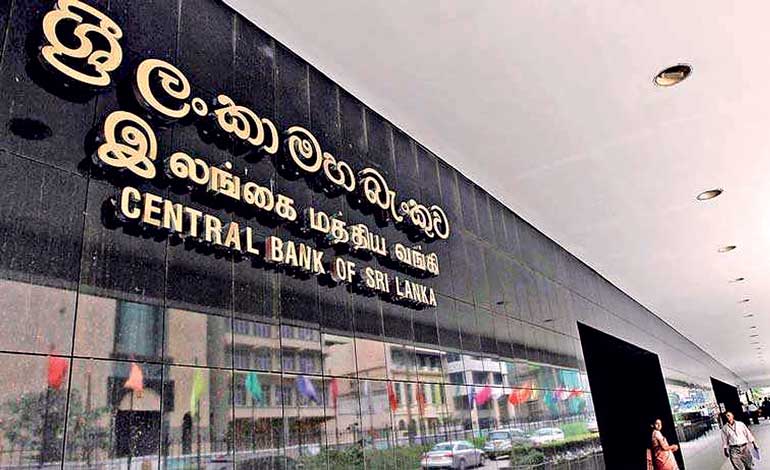Saturday Apr 26, 2025
Saturday Apr 26, 2025
Tuesday, 28 September 2021 03:00 - - {{hitsCtrl.values.hits}}

It is questionable how far the so-called home-grown solutions are going to be successful without implementing a credible structural reform package to rectify the inherent macroeconomic imbalances. This is not the time to reinvent the wheel
 The inherent economic problems faced by Sri Lanka have been compounded since last year by the spread of the COVID-19 pandemic in several rounds. In this background, it is encouraging to observe that the export sector and the overall economic activities show signs of recovery this year despite the pandemic.
The inherent economic problems faced by Sri Lanka have been compounded since last year by the spread of the COVID-19 pandemic in several rounds. In this background, it is encouraging to observe that the export sector and the overall economic activities show signs of recovery this year despite the pandemic.
Nevertheless, the macroeconomic imbalances manifested by the twin deficits – the fiscal deficit and the balance of payments deficit – have aggravated exerting adverse consequences on economic growth, cost of living, international reserves, exchange rate management, debt sustainability, and many other spheres.
In particular, Sri Lanka’s debt sustainability is found to be fragile, in terms of the international debt sustainability assessments. Hence, drastic policy reforms are essential to address the country’s debt volatility driven by the high fiscal deficit and weak balance of payments.
However, Central Bank Governor Ajith Nivard Cabraal, last week at a webinar on Sri Lanka’s debt sustainability co-hosted by Daily FT, categorically rejected the idea that Sri Lanka is facing a debt crisis. He stated that the current economic problems, which are temporary, will be tackled by a workable home-grown solution to be announced by him in a roadmap in early October. While ruling out seeking an IMF bailout, he stressed that there is enough expertise within the Central Bank to deal with debt repayment.
Home-grown solutions
Former Central Bank Governor Prof. W.D. Lakshman too reiterated that the economic problems could be sorted out by home-grown policies without resorting to the IMF. Such intentions became futile within a short time span, as reflected in the exchange rate volatility, foreign reserve depletion, consumer goods shortages, and inflationary pressures.
The so-called home-grown solutions adopted so far seem to be characterised by some standalone measures such as exchange rate fixing, interest rate caps, administrative credit allocations, export proceeds conversion regulations, the favourable exchange rate for migrant remittances, and credit margins on imports. These types of policy measures were in vogue during the heydays of the import substitution regimes across developing countries including Sri Lanka several decades ago.
A major shortcoming of the home-grown policies is that they focus on particular segments of the economy instead of taking into account the overall economic interactions. These are direct monetary and exchange controls that deviate from the market-based monetary policy instruments that were introduced in the 1980s and 1990s.
While adopting the home-grown policy measures without credible structural reforms, the Central Bank has no choice other than to continue injecting liquidity to meet budgetary shortfalls along the lines of the flawed Modern Monetary Theory (MMT), and to administratively fix the exchange rate supplemented by a host of import and exchange control regulations, as I argued in the last week’s column (https://www.ft.lk/columns/CB-likely-to-continue-money-expansion-direct-controls/4-723299).
Monetary expansion
Fiscal deficits have been cited as a major cause of persistent inflation in developing countries due to the monetisation of a significant share of the deficits that are not financed either by foreign borrowings or domestic non-bank borrowings. Once the Government gets stuck with such imbalances, as in the case of Sri Lanka at present, it is unavoidable to resort to seigniorage, commonly known as money printing.
Fiscal dominance limits the ability of the Central Bank to control its monetary base and reduce inflation, as evident from Sri Lanka’s current experience. Continuous lending to the Government by CBSL has resulted in a substantial increase in its holdings of Treasury bills and bonds. Such holdings rose by 52% from Rs. 874 billion to Rs. 1,330 billion during the last 3 months
The resulting increase in the Central Bank’s monetary base has led to an increase in the aggregate money supply by several times owing to the working of the money multiplier. The aggregate money supply rose by as much as 22% over the last 12 months.
The excess liquidity has already generated inflationary pressures reflecting a rise in the headline inflation to 6.7%, as measured in terms of the year-on-year change in the National Consumer Price Index. The Government seems to have preferred this type of ‘inflation taxation’ to avoid becoming unpopular by mobilising normal taxes from individuals and companies, particularly ahead of local-level polls to be held next year.
CB independence essential
As I have repeatedly pointed out in the previous columns of this series, freeing the Central Bank from political interference is essential for price stability.
Presenting his famous presidential address to the American Economic Association in 1968, Milton Friedman, the celebrated architect of Monetarism, explained what monetary policy can do, and what it cannot. He noted that the monetary policy cannot influence output, employment, or real rates of return on assets in the long run. But he stressed that monetary policy can exercise considerable control over inflation in the long run.
Recognising the importance of setting up an independent Central Bank way back in 1949, the then Minister of Finance J.R. Jayewardene had the foresight to state in the Parliament: “It is very difficult to say that the Central Bank should be entirely a department of the Government or subservient to the Government. We have tried as far as we could, in this Act to make the Central Bank or at least the Monetary Board, independent as far as its advice is concerned. We want it to consider the problems of Ceylon, … to see how far it is necessary that the credit structure of Ceylon should be influenced for the purpose of full employment and the balance of payments. We want it to consider this question apart from political considerations and give its advice without fear or favour to the Government. But, ultimately, in the last analysis, I think it would be admitted that the Monetary Board cannot come into direct conflict with the Government.”
Unpleasant monetarist arithmetic
Friedman’s argument was first challenged by Thomas J. Sargent and Neil Wallace in their “unpleasant monetarist arithmetic” doctrine presented in 1981. They argued that central bank independence is only a necessary, but not a sufficient condition to attain price stability.
They asserted that the Government’s approach to the problem of fiscal solvency can severely limit the scope available for monetary policy options. If the fiscal authority sets its deficit independently, and when such deficit cannot be financed solely by selling new bonds, the Central Bank is compelled to create money and allow inflation to go up. This is exactly what is happening in Sri Lanka right now.
Fiscal dominance vs. monetary dominance
According to Sargent and Wallace, the extent to which the Government’s budgetary constraints bind the central bank, and thereby limits its ability to control inflation permanently depends on how fiscal and monetary policies are coordinated. So, there are two polar forms of coordination – monetary dominance and fiscal dominance.
Monetary dominance prevails when the central bank focuses entirely on controlling inflation, whereas the fiscal authorities adjust budgetary operations to remain solvent subject to the exogeneous flow of seigniorage. Accordingly, the central bank independently sets monetary policy, and thus, it determines the amount of revenue that it will supply to the fiscal authority through seigniorage. Monetary dominance can be considered as a situation where monetary policy is ‘active’ and fiscal policy is ‘passive’.
By contrast, fiscal dominance exists when the monetary policy is subject to the constraint of providing sufficient seigniorage to the Government to ensure fiscal solvency. Under this coordination scheme, the central bank faces the constraint imposed by the demand for Government securities as the bank is compelled to finance with seigniorage the part of the budget deficit not financed by other sources.
Policy options
The solution offered in the standard monetarist doctrine to achieve price stability is to make sure that the central bank has an unwavering commitment to price stability. The monetarist doctrine recognises the importance of both fiscal and monetary policies in achieving price stability.
The home-grown solutions do not seem to tackle the fundamental macroeconomic imbalances - fiscal deficit and external deficit – by adopting a coherent package of structural reforms. It is essential to reduce the budget deficit by increasing the tax revenue and pruning non-essential government expenditure. The tax reforms, which are imperative to reverse the revenue shortfalls created by the last year’s tax cuts, do not seem to be on the current policy agenda.
The Government expenditure continues to rise without having any plans to rationalize exorbitant expenditure. Ahead of local-level polls, for example, additional project funding is to be allocated to the District Development Committee members. Meanwhile, the Parliament increased the Government’s borrowing limit by Rs. 400 billion a few days ago.
The fiscal targets envisaged in the Fiscal Responsibility Act are now postponed until 2030. The initiatives taken three years ago to strengthen Central Bank independence with an inflation-targeting monetary policy framework coupled with fiscal discipline have been abandoned, as I reiterated in the previous articles of this column.
In this context, it is questionable how far the so-called home-grown solutions are going to be successful without implementing a credible structural reform package to rectify the inherent macroeconomic imbalances. This is not the time to reinvent the wheel.
(The writer is Emeritus Professor of Economics at the Open University of Sri Lanka and a former Central Banker, reachable at [email protected])
Discover Kapruka, the leading online shopping platform in Sri Lanka, where you can conveniently send Gifts and Flowers to your loved ones for any event including Valentine ’s Day. Explore a wide range of popular Shopping Categories on Kapruka, including Toys, Groceries, Electronics, Birthday Cakes, Fruits, Chocolates, Flower Bouquets, Clothing, Watches, Lingerie, Gift Sets and Jewellery. Also if you’re interested in selling with Kapruka, Partner Central by Kapruka is the best solution to start with. Moreover, through Kapruka Global Shop, you can also enjoy the convenience of purchasing products from renowned platforms like Amazon and eBay and have them delivered to Sri Lanka.
Discover Kapruka, the leading online shopping platform in Sri Lanka, where you can conveniently send Gifts and Flowers to your loved ones for any event including Valentine ’s Day. Explore a wide range of popular Shopping Categories on Kapruka, including Toys, Groceries, Electronics, Birthday Cakes, Fruits, Chocolates, Flower Bouquets, Clothing, Watches, Lingerie, Gift Sets and Jewellery. Also if you’re interested in selling with Kapruka, Partner Central by Kapruka is the best solution to start with. Moreover, through Kapruka Global Shop, you can also enjoy the convenience of purchasing products from renowned platforms like Amazon and eBay and have them delivered to Sri Lanka.